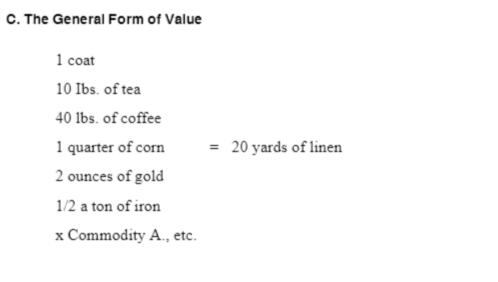
1. The altere d character of the fom of valueAll commodities now express their value (1)in an elementary form, because in a single commodity; (2)with unity, because in one and the same commodity. This form of value is elementary and the same forall, therefore general
The forms A and b were fit only to express the value of a commodity as something distinct from itsuse-value or material formThe first-form, A, furnishes such equations as the following:20 yards of linen,10 lbs of tea=12 a ton of ironThe value of the coat is equated to linen, that of the tea to iron. But to be equated to linen, and again toiron, is to be as different as are linen and iron. This forms it is plain, occurs practically only in the firstbeginning, when the products of labour are converted into commodities by accidental and occasionalexchangesThe second form, B, distinguishes, in a more adequate manner than the first, the value of a commodityfrom its use- value, for the value of the coat is there placed in contrast under all possible shapes with thebodily form of the coat; it is equated to linen, to iron, to tea, in short, to everything else, only not to itself,the coat On the other hand, any general expression of value common to all is directly excluded; for, inthe equation of value of each commodity, all other commodities now appear only under the form ofequivalents. The expanded form of value comes into actual existence for the first time so soon as aparticular product of labour, such as cattle, is no longer exceptionally, but habitually, exchanged forvarous other commoditiesThe third and lastly developed form expresses the values of the whole world of commodities in terms ofa single commodity set apart for the purpose, namely, the linen, and thus represents to us their values byans of their equality with linen. The value of every commodity is now, by being equated to linen, notonly differentiated from its own use-value, but from all other use-values generally, and is, by that veryact, expressed as that which is common to all commodities. By this form, commodities are, for the firsttime, effectively brought into relation with one another as values, or made toexchange-valuesThe two earlier forms either express the value of each commodity in terms of a single commodity of adifferent kind, or in a series of many such commodities. In both cases, it is, so to say, the special businessof each single commodity to find an expression for its value, and this it does without the help of theothers. These others, with respect to the former, play the passive parts of equivalents. The general formof value, C, results from the joint action of the whole world of commodities, and from that alone. Acommodity can acquire a general expression of its value only by all other commodities, simultaneouslyith it, expressing their values in the same equivalent; and every new commodity must follow suit. Itthus becomes evident that since the existence of commodities as values is purely social, this socialexistence can be expressed by the totality of their social relations alone, and consequently that the formof their value must be a socially recognised form.
All commodities being equated to linen now appear not only as qualitatively equal as values generallybut also as values whose magnitudes are capable of comparison By expressing the magnitudes of theirvalues in one and the same material, the linen, those magnitudes are also compared with each other Forinstance,10 Ibs of tea= 20 yards of linen, and 40 lbs, of coffee= 20 yards of linen. Therefore, 10 Ibs oftea=40 Ibs of coffee. In other words, there is contained in 1 Ib of coffee only one-fourth as muchsubstance of value -labourcontained in 1 1b. of teaThe general form of relative value, embracing the whole world of commodities, converts the singlecommodity that is excluded from the rest, and made to play the part of equivalent-here the lineninto the universal equivalent. The bodily form of the linen is now the form assumed in common by thevalues of all commodities; it therefore becomes directly exchangeable with all and every of them. Thesubstance linen becomes the visible incarnation, the social chrysalis state of every kind of human labourWeaving, which is the labour of certain private individuals producing a particular article, linen, acquiresin consequence a social character, the character of equality with all other kinds of labour. Theinnumerable equations of which the general form of value is composed, equate in turn the labourembodied in the linen to that embodied in every other commodity, and they thus convert weaving into thegeneral form of manifestation of undifferentiated human labour. In this manner the labour realised in thevalues of commodities is presented not only under its negative aspect, under which abstraction is madefrom every concrete form and useful property of actual work, but its own positive nature is made toreveal itself expressly. The general value-form is the reduction of all kinds of actual labour to theircommon character of being human labour generally, of being the expenditure of human labour-powerThe general value-form, which represents all products of labour as mere congelation of undifferentiatedhuman labour, shows by its very structure that it is the social resume of the world of commodities. Thatform consequently makes it indisputably evident that in the world of commodities the characterpossessed by all labour of being human labour constitutes its specific social character.
